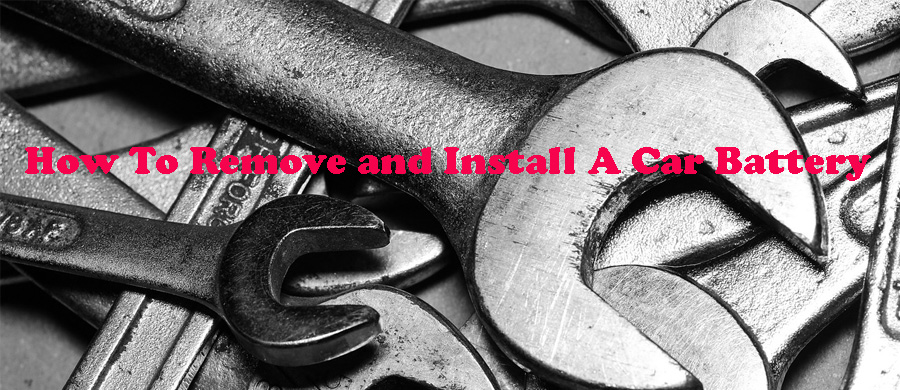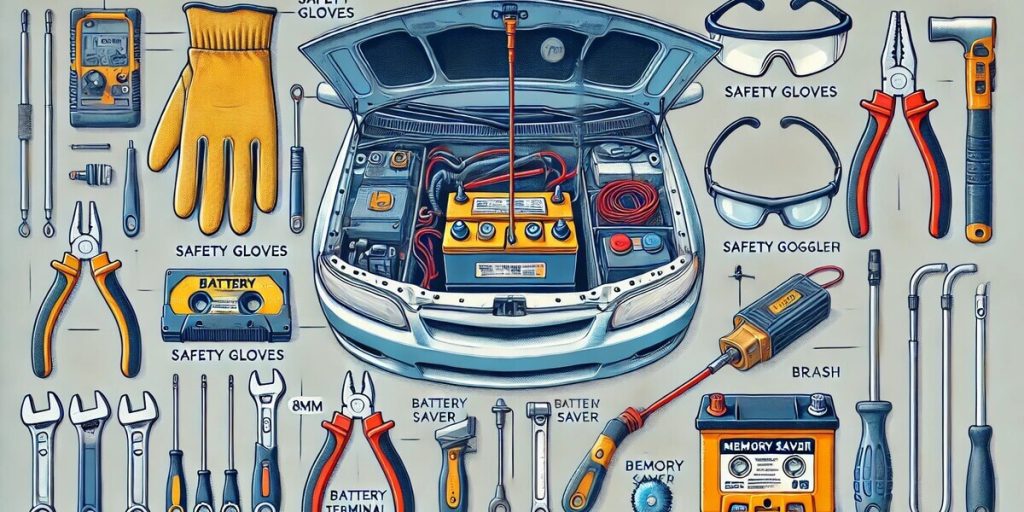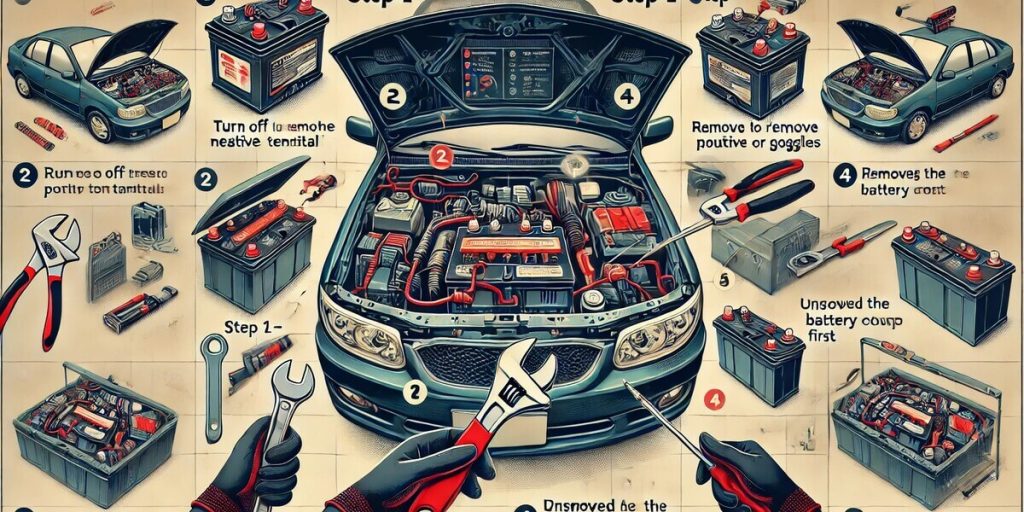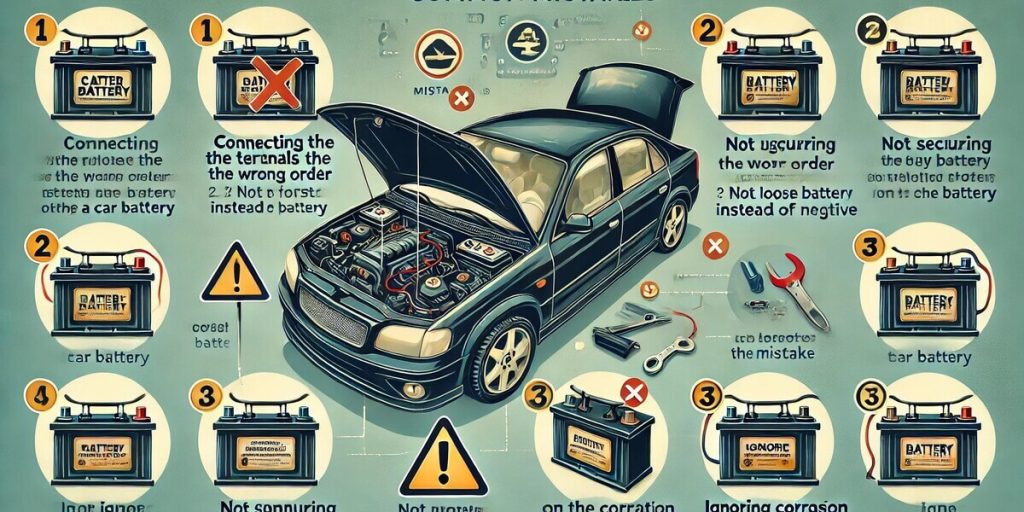Last Updated on February 12, 2025 by Mark S. Taylor
Last winter, my car wouldn’t start, and I was stuck in the cold, waiting for a jump. Turns out, I needed a new battery—something I could have handled myself if I had known how to remove and install a car battery. A weak battery can leave you stranded at the worst moments, but replacing it is easier than you think. In this guide, I’ll show you how to swap out your battery safely, whether you’re at home or on the go. Let’s get your car back up and running!

Contents
Signs You Need a New Car Battery
Your car battery won’t last forever, and when it starts failing, your car will give you warning signs. Ignoring them can leave you stranded. Here’s how to know when it’s time for a new battery.
1. Slow Engine Cranking
If your engine takes longer to start or sounds weaker than usual, your battery may be losing power. A strong battery starts the engine fast. If it struggles, it’s a sign to replace it.
2. Dim Headlights and Electrical Issues
Your battery powers everything from headlights to power windows. If lights flicker or windows move slowly, the battery may be too weak. Dimming lights at idle? That’s a red flag.
3. Battery Warning Light on the Dashboard
Most cars have a battery-shaped warning light that turns on when voltage is low. If it stays on while driving, your battery or alternator may be failing.
4. Corroded Terminals or a Swollen Battery Case
Look under the hood—white or blue buildup on battery terminals can block power flow. If the battery case looks bloated, heat damage may be the cause. That means it’s time to replace it.
5. Hard Starts in Cold Weather
Car batteries lose power in cold temperatures. If your car struggles more on chilly mornings, your battery may be wearing out. If it’s over three years old, get it tested.
I once ignored these signs, thinking my battery still had life. Then one morning, my car wouldn’t start at all. A quick replacement saved me from an expensive tow. If your car shows these symptoms, don’t wait—replace your battery before it leaves you stranded!

Tools Needed for Removing and Installing a Car Battery
Swapping out a car battery is simple if you have the right tools. A few basic items can make the job safer and easier. Here’s what you need.
1. Safety Gloves and Goggles
Car batteries contain acid and can spark. Gloves protect your hands from corrosion, and goggles keep your eyes safe from splashes or sparks.
2. Wrenches or a Socket Set (8mm, 10mm, 13mm)
Most battery terminals use 8mm, 10mm, or 13mm nuts. A socket wrench or adjustable wrench will loosen them fast. A ratchet wrench makes it even easier!
3. Battery Terminal Cleaner or Wire Brush
Corroded terminals block power flow. A wire brush or battery cleaner removes dirt and buildup, helping your battery work better. No brush? Baking soda and water work too!
4. Battery Holder (to Keep It Secure While Driving)
A loose battery can move around, damaging wires. The battery holder keeps it locked in place, preventing electrical issues.
5. Memory Saver Device (to Keep Car Settings Intact)
Some cars reset radio stations, clocks, and even engine settings when you remove the battery. A memory saver plugs into the cigarette lighter to prevent this. It’s a must-have for modern vehicles!
I once replaced a battery without a memory saver—my car forgot everything, even the idle speed! Now, I always use one. With these tools, swapping a car battery is quick and stress-free.
Step-by-Step Guide to Removing a Car Battery
Removing a car battery is easy, but doing it the right way keeps you safe and prevents damage to your car’s electrical system. Follow these simple steps to get it done smoothly.
1. Safety First
Before touching anything, park on a flat surface and turn off the engine. Remove the key to make sure there’s no power running through the system. Put on gloves and safety goggles—batteries contain acid, and you don’t want that on your skin or eyes.
2. Which Terminal to Remove First?
Always disconnect the negative (-) terminal first. This helps prevent sparks or accidental short circuits. Use a wrench to loosen the bolt, then remove the cable. After that, disconnect the positive (+) terminal the same way. Pro tip: Keep the cables away from any metal parts to avoid sparks.
3. Removing the Battery from the Car
Find the battery holder or clamp—it keeps the battery in place so it doesn’t move while driving. Use a wrench to loosen and remove it. Once the clamp is off, carefully lift the battery straight up—it can be heavy, so get a good grip! Avoid tilting it, as battery acid can leak.
I remember the first time I changed my battery, I grabbed it too fast and nearly dropped it—lesson learned! Take your time, use both hands, and you’ll be just fine. Now that the battery is out, you’re ready for the next step: installing the new one.

How to Install a New Car Battery
Installing a new car battery is easy if you follow the right steps. A secure, clean connection ensures your car starts without issues. Here’s what to do.
1. Preparing the Battery
Before placing the new battery, clean the battery tray and terminals with a wire brush. Dirt and corrosion can weaken the connection. Apply a thin layer of anti-corrosion grease to prevent rust.
2. Which Terminal to Connect First?
Always connect the positive (+) terminal first. This reduces the risk of sparks or short circuits. Once it’s secure, attach the negative (-) terminal. Make sure both clamps are tight to avoid power loss.
3. Securing the Battery
Use the battery clamp to hold the battery in place. A loose battery can shift while driving, causing electrical problems. Before closing the hood, give the battery a gentle tug to check that it’s secure.
I once forgot to tighten the clamp, and my car wouldn’t start after a bumpy road trip. Now, I always double-check! Follow these steps, and your new battery will work perfectly.
How to Change a Car Battery Without Losing Settings
Replacing your car battery shouldn’t mean losing your radio presets, clock time, or engine memory. With a little preparation, you can keep everything just the way it was.
Use a Memory Saver Device
A memory saver plugs into your car’s OBD port or cigarette lighter and keeps power flowing while you swap the battery. This prevents resets, so you don’t have to fix anything later. It’s a simple tool that saves time.
No Memory Saver? Reset Settings Manually
If you don’t have a memory saver, write down your radio stations and clock time before removing the battery. Some cars may reset idle speed or power windows, so check the owner’s manual for reprogramming steps.
I once skipped this step and lost all my settings—even my seat memory! Now, I always use a memory saver. A little planning makes battery changes stress-free.
Common Mistakes When Replacing a Car Battery
Replacing a car battery is simple, but small mistakes can cause big problems. Avoid these common errors to keep your car running smoothly.
1. Connecting the Terminals in the Wrong Order
Always connect the positive (+) terminal first, then the negative (-). Doing it backward can cause sparks or damage your car’s electronics. Double-check before tightening!
2. Not Securing the Battery Properly
A loose battery can move while driving, damaging wires or causing a short. Make sure the hold-down clamp is tight so the battery stays in place. Give it a small shake—if it moves, tighten it!
3. Ignoring Corrosion on the Terminals
Corroded terminals block power flow and make your battery work harder. Before installing a new battery, clean the terminals with a wire brush and apply anti-corrosion grease. This keeps your connections strong.
The first time I changed my battery, I forgot to tighten the clamp. A week later, my car wouldn’t start because the battery had shifted! Now, I always check my work. A few extra seconds can save you from a lot of trouble.

What to Do with Your Old Car Battery?
So, you’ve swapped out your car battery—but don’t just toss the old one! Car batteries contain toxic materials that can harm the environment if not disposed of properly.
Take It to an Auto Parts Store or Recycling Center
Most auto parts stores and recycling centers accept old car batteries. Some even offer cash or store credit when you recycle with them. It’s a quick, easy way to do the right thing!
Why Proper Disposal Matters
Car batteries contain lead, acid, and other harmful chemicals. If thrown in the trash, they can leak and pollute soil and water. Recycling ensures these materials are handled safely.
The first time I replaced my battery, I didn’t know what to do with the old one. Then I found out my local shop gave me a $10 credit for recycling it! Check with your local stores—you might get rewarded for going green.
Car Battery Replacement Cost
Replacing a car battery doesn’t have to break the bank, but costs can vary depending on how you do it. Here’s what to expect.
DIY Cost: $80–$200
A new car battery typically costs $80 to $200, depending on the brand and type. If you install it yourself, you save on labor fees. Many auto parts stores even install it for free if you buy the battery from them.
Professional Installation: $150–$300
If you go to a mechanic, expect to pay $150 to $300, which includes labor and diagnostics. Some dealerships charge even more. If you’re comfortable with basic tools, DIY is the cheaper option.
The first time I changed my battery, I paid a shop $180 for a $100 battery—lesson learned! Now, I do it myself and save money. Whether you go DIY or hire a pro, knowing your options helps you make the best choice.
FAQs About Removing and Installing a Car Battery
Q: How long does it take to change a car battery?
A: It takes about 15–30 minutes to replace a car battery. With the right tools, it’s a quick and easy process.
Q: Do I need to reset my car after installing a new battery?
A: Some cars reset settings like the radio, clock, and idle speed. Using a memory saver device helps keep everything in place.
Q: How do I know what type of battery fits my car?
A: Check your owner’s manual or look at the label on your old battery. Most auto parts stores can also help you find the right one.
Q: Can I change my car battery at home?
A: Yes! You only need a wrench and basic safety gear. Always disconnect the negative (-) terminal first to prevent electrical issues.
Q: What happens if I connect the terminals incorrectly?
A: Reversing the terminals can cause sparks or damage your car’s electrical system. Always connect the positive (+) first, then the negative (-).
My Final Thoughts on Replacing a Car Battery
If you like saving money and fixing things yourself, replacing a car battery is an easy win. With basic tools and the right steps, you can do it in 30 minutes or less. But if handling cables makes you nervous, getting professional help is always an option.
Either way, knowing how it works helps you avoid costly mistakes. Keep a memory saver, follow the correct terminal order, and secure the battery properly. A little prep goes a long way in keeping your car running smoothly!
